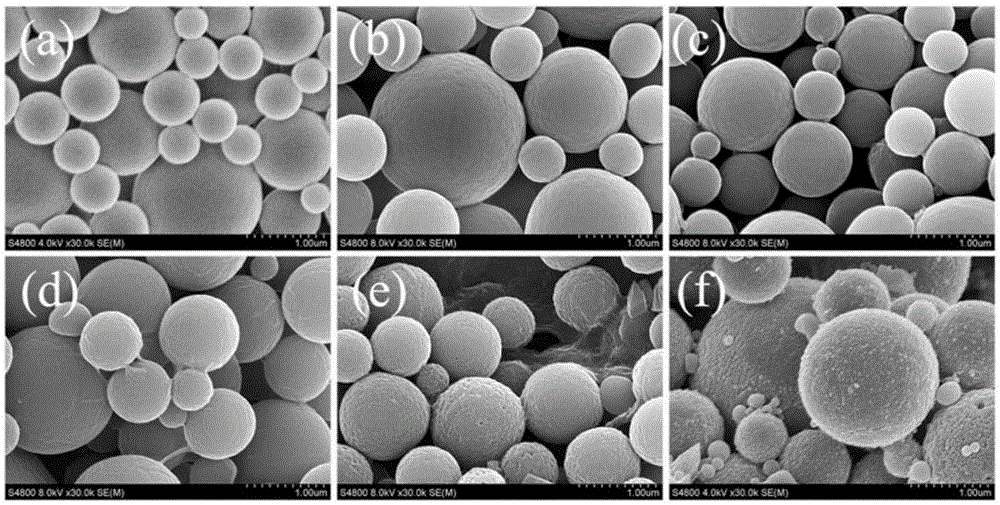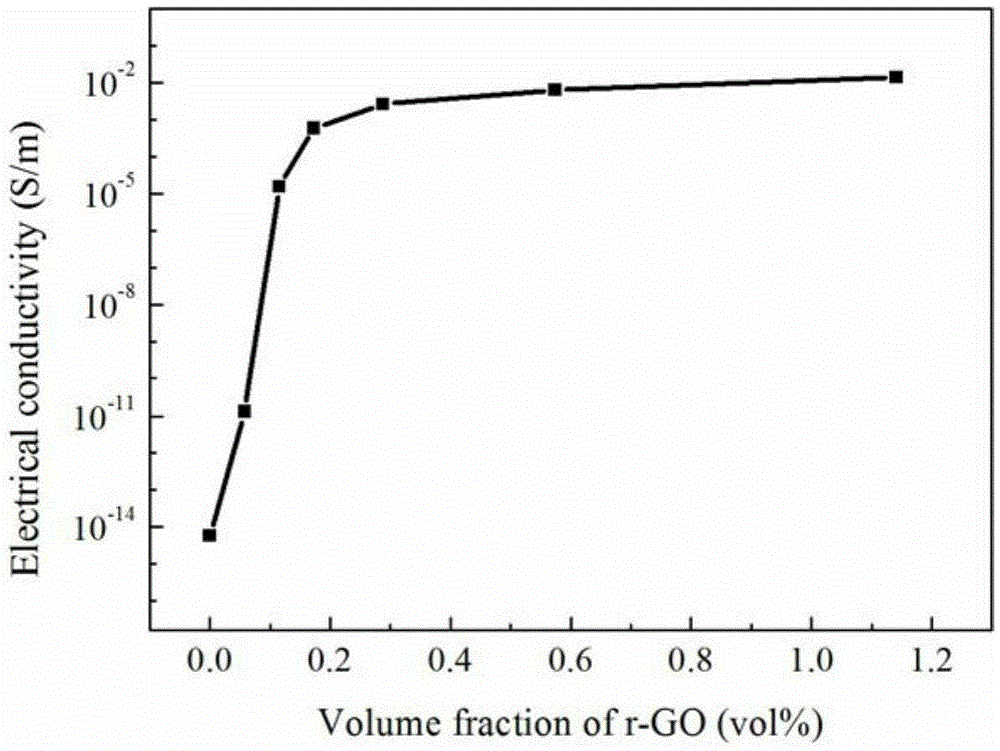High-conductivity polyimides-graphene composite material and preparation method thereof
A technology of polyimide and high conductivity, which is applied in the field of high conductivity polyimide-graphene composite materials and its preparation, and can solve the problems of difficult dispersion of graphene, high percolation threshold, cumbersome process, etc. , to achieve the effect of simple and practical molding method, high electrical conductivity and simplified process
- Summary
- Abstract
- Description
- Claims
- Application Information
AI Technical Summary
Problems solved by technology
Method used
Image
Examples
Embodiment 1
[0040]Add 0.6 g of self-made polyimide microspheres into a 100 ml single-necked flask, add 54 g of deionized water, stir and disperse evenly, and obtain a dispersion of polyimide microspheres. Add 0.6 mg of self-made graphene oxide (see: Journal of the American Chemical Society 1958; 80:1339 for specific preparation method) into 6 g of deionized water, and ultrasonically disperse for 1 hour to obtain a graphene oxide dispersion. Then the graphene oxide dispersion was slowly added to the polyimide microsphere dispersion, and stirred at 25° C. for 1 h to obtain a graphene oxide-coated polyimide microsphere dispersion. Next, 0.02 g of hydrazine hydrate was added to the solution, and the reaction solution was heated to 90° C. for 24 hours of reaction. Centrifuged and washed 3 times to obtain polyimide microspheres coated with reduced graphene oxide.
[0041] Wherein, the preparation method of polyimide microsphere is as follows:
[0042] (1) Add polyimide to N,N-dimethylacetamid...
Embodiment 2
[0050] Add 0.6 g of self-made polyimide microspheres into a 100 ml single-necked flask, add 48 g of deionized water, stir and disperse evenly, and obtain a dispersion of polyimide microspheres. Add 1.2 mg of self-made graphene oxide into 6 g of deionized water, and ultrasonically disperse for 1 hour to obtain a graphene oxide dispersion. Then the graphene oxide dispersion was slowly added to the polyimide microsphere dispersion, and stirred at 25° C. for 1 h to obtain a graphene oxide-coated polyimide microsphere dispersion. Next, 0.04 g of hydrazine hydrate was added to the solution, and the reaction solution was heated to 90° C. for 24 hours of reaction. Centrifuged and washed 3 times to obtain polyimide microspheres coated with reduced graphene oxide.
[0051] Scanning electron microscopy showed that the surface of the microspheres was slightly coated with a layer of graphene, and the intensity of the PI characteristic peak on the Raman spectrum peak was weakened.
[0052...
Embodiment 3
[0054] Add 0.6 g of self-made polyimide microspheres into a 100 ml single-necked flask, add 42 g of deionized water, stir and disperse evenly, and obtain a dispersion of polyimide microspheres. Add 1.8 mg of self-made graphene oxide into 18 g of deionized water, and ultrasonically disperse for 1 hour to obtain a graphene oxide dispersion. Then the graphene oxide dispersion was slowly added to the polyimide microsphere dispersion, and stirred at 25° C. for 1 h to obtain a graphene oxide-coated polyimide microsphere dispersion. Next, 0.05 g of hydrazine hydrate was added to the solution, and the reaction solution was heated to 90° C. for 24 hours of reaction. Centrifuged and washed 3 times to obtain polyimide microspheres coated with reduced graphene oxide.
[0055] Scanning electron microscopy showed that the surface of the microspheres was slightly coated with a layer of graphene, and the intensity of the PI characteristic peak on the Raman spectrum peak was weakened.
[005...
PUM
| Property | Measurement | Unit |
|---|---|---|
| The average particle size | aaaaa | aaaaa |
| Conductivity | aaaaa | aaaaa |
Abstract
Description
Claims
Application Information
 Login to View More
Login to View More - Generate Ideas
- Intellectual Property
- Life Sciences
- Materials
- Tech Scout
- Unparalleled Data Quality
- Higher Quality Content
- 60% Fewer Hallucinations
Browse by: Latest US Patents, China's latest patents, Technical Efficacy Thesaurus, Application Domain, Technology Topic, Popular Technical Reports.
© 2025 PatSnap. All rights reserved.Legal|Privacy policy|Modern Slavery Act Transparency Statement|Sitemap|About US| Contact US: help@patsnap.com


